Nearly a decade ago, I had the incredible pleasure of riding with a friend from Alicante, Spain, north along the Mediterranean Sea to Barcelona before heading inland and across the Pyrenees through Andorra and into France. After a night in Orange, France, we continued north over the Alps, touching the eastern tip of Italy before entering Switzerland and eventually arriving at our destination of Niedereschach, Germany, Touratech’s world headquarters for their Travel Event–Touratech’s annual international rally. After a few days there, we traveled north to Berlin for a tour of the BMW Motorrad factory before returning home.
For much of the last 20 years, my wife had longed to visit Europe and Spain in particular. But for some reason, we were just never able to make it happen together. With that in mind, when I returned from my ride with Paul, I felt as though I was keeping a secret from her as I couldn’t tell her just how amazing that trip was.
Just over a year ago, given the opportunity to join an MOA tour of Spain and Portugal with IMTBike, we were finally able to visit Europe together and share a great adventure. The only caveat is that we’d be on a motorcycle, and Judy’s only previous motorcycle experience had happened about a decade earlier when she rode with me for about an hour. Though unsure of how or if she’d enjoy seeing these two countries from the back of a motorcycle, she was willing to give it a go. We were finally going to Spain together!
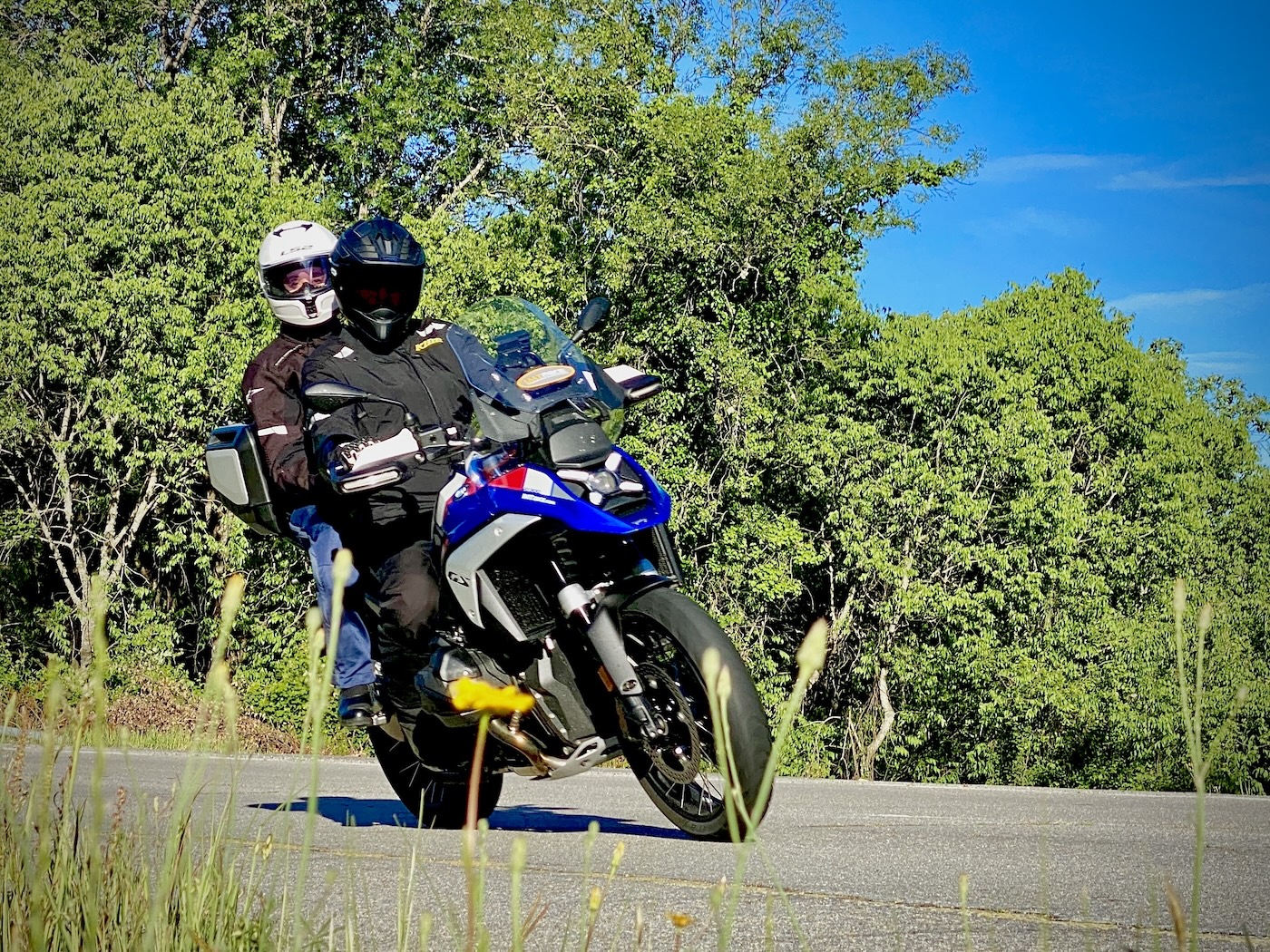
Relaying Judy’s apprehension to Scott Moreno, owner of IMTBike, he assured me that if she wasn’t enjoying her experience from the back of a bike, she would be welcomed into the chase van, where she could work on her Spanish with the driver. With that, our plans became real!
Our tour began with our flight into Madrid, where IMTBike has its headquarters. Once there, Judy and I caught a shuttle to our hotel for the evening and were pleased to find that the hotel staff were expecting us and had already received all our pertinent information from IMTBike. Our arrival packet described that afternoon’s introductory meeting, where we would meet the other riders on the tour before heading out for our first experience with authentic Spanish cuisine. Until then, Judy and I took the opportunity to get out and see a bit of Madrid.
Later that afternoon, we met the 13 other riders we would be riding with over the next two weeks, along with our two IMTBike guides, Sergi and Chano. Except for a couple from Australia and another from New Zealand, all were MOA members from the USA. Once finished with personal introductions, Sergi and Chano gave us a brief introduction into traffic and safety issues for European riding and a 60-page tour handbook that not only explained what we could expect each day, but also gave us additional information including Spanish and Portuguese history and customs, along with details regarding climate, traffic, staying in touch and essential emergency information.
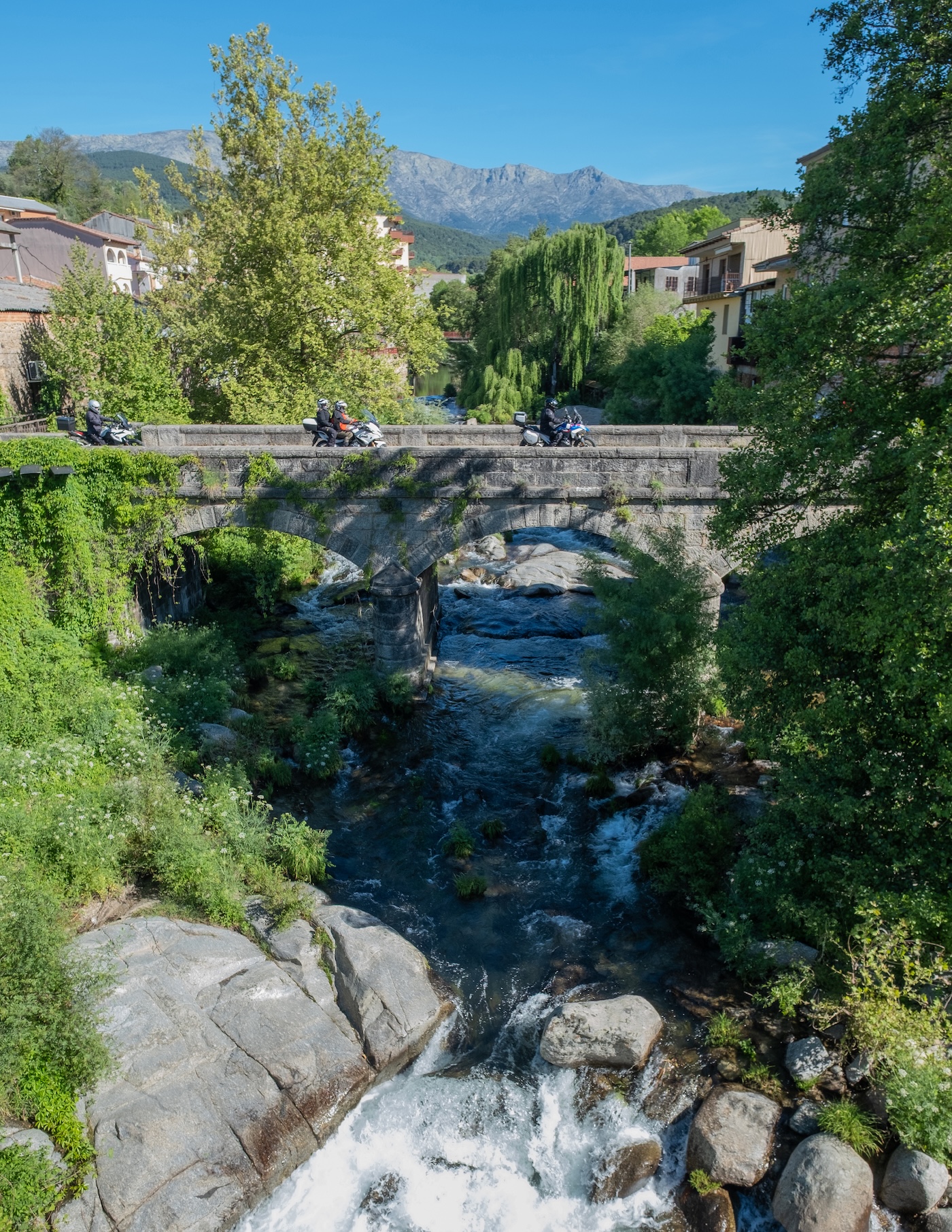
Spain shares borders with Portugal to the west, France and Andorra to the north and Gibraltar to the south. More than 60% of the land area, including the large central plateau, is mountainous, giving Spain the highest mean elevation of all Western European countries except Switzerland. These significant mountain systems include the Cantabrian and Pyrenean Mountains in the north and the Sierra Morena in the south. IMTBike emphasizes riding little-known secondary roads and our tour would begin and end in Madrid while taking us nearly 1,800 miles through breathtaking terrain to the easternmost point of Portugal before winding back to Madrid.
By the end of our initiation and giddy with the enthusiasm of what was to come, we made our way to El Retiro Park, one of the largest in Madrid covering more than 300 acres, for an introduction to Spanish cuisine at a tapas bar. During our dinner, we received our first lesson on Spanish culture and time.
As explained in our tour handbook, a typical Spanish workday begins at 9 a.m. and stops between 1:30 p.m. and 4:30 p.m. for lunch. The afternoon shift runs until about 8:30 p.m., when Spaniards enjoy socializing over a glass of wine, some cheese and ham before returning home to eat a light dinner around 10 p.m. The Portuguese follow a similar schedule. Following our late dinner, we headed back to the hotel to try to sleep before beginning our tour the next day.
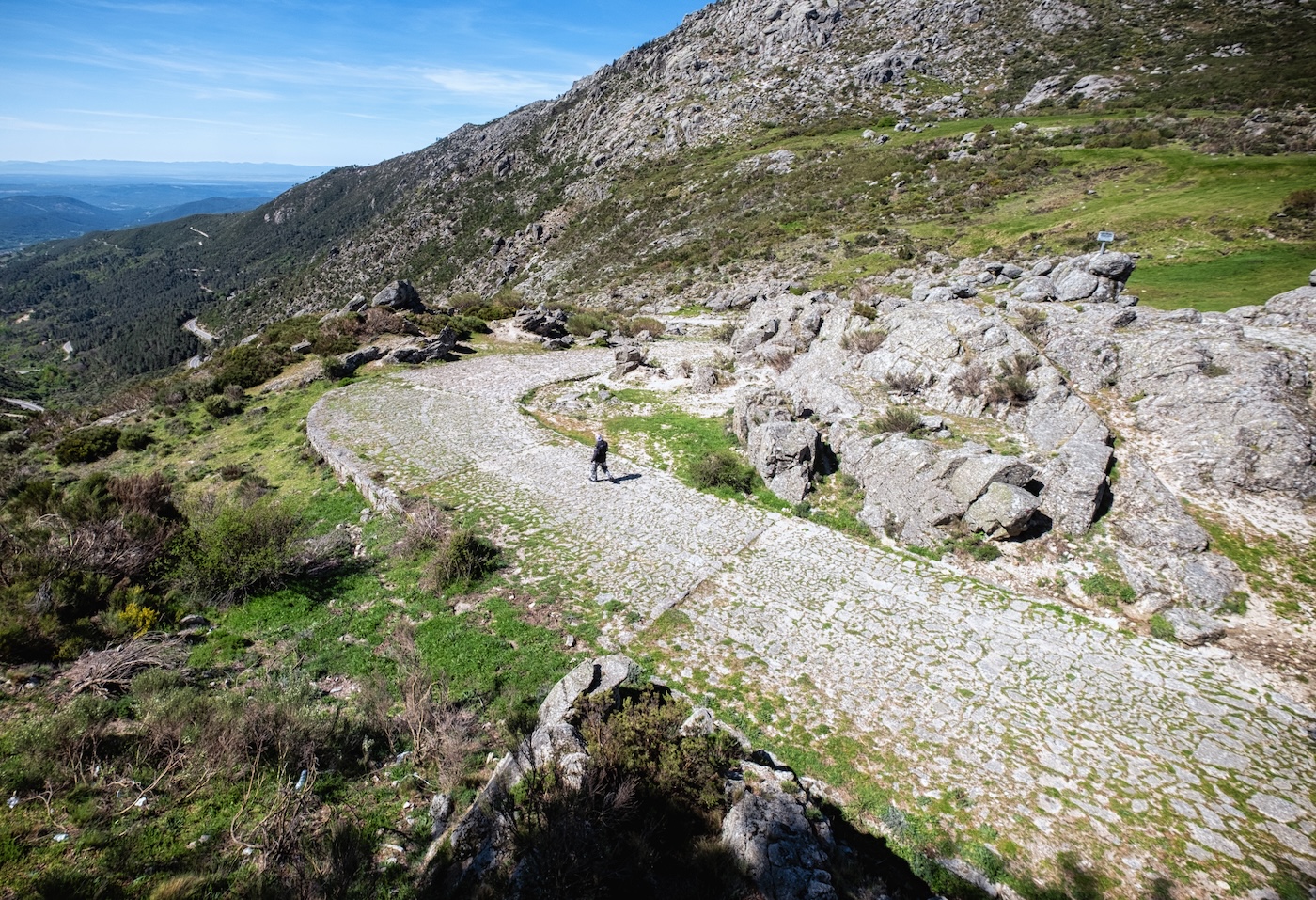
After breakfast the next morning, we were shuttled to IMTBike’s headquarters to familiarize ourselves with our rides for the next two weeks. Nearly all of IMTBike’s motorcycles are BMWs, and as a GS rider, I chose to ride a new R 1300 GS. This would not only be my first experience with the new 1300, but also the first time I’ve carried a passenger for more than an hour. Although I felt confident getting acquainted with the GS, riding with my wife behind me raised some concerns. Another concern was that it was April, and because Judy and I live in the northern United States, I hadn’t done any significant riding for the past six months–I was rusty.
Riding away from the IMTBike offices, we jumped on the freeway to quickly get away from the city. With the Guadarrama Mountains in the distance, we were heading toward our first stop of the day in El Escorial. The easy sweepers into the mountains reminded me of the Cherohala Skyway, which I’ve ridden many times during the MOA Getaways at Fontana. The sweepers provided an opportunity to both get used to the handling of the GS while carrying a passenger. Like North Carolina, pines and hardwood trees lined the roadsides of the beautiful asphalt we rode. According to our guides, this area is popular with motorcyclists escaping Madrid in search of twisty roads on the weekends. In the winter months, the area is popular with skiers. Luckily for us, midweek traffic was light.
It didn’t take long before the gentle curves became tighter, demanding more attention to speed and line as we continued our ascent. With each corner the last words my daughter said to me at the airport (“Don’t kill mom!”) repeated in my head. Being the first significant ride I’ve taken with Judy, I didn’t invest in a communication system for us. Instead, an occasional finger pointing to something interesting or an old-school punch in the ribs let me know what she was thinking as we rode.
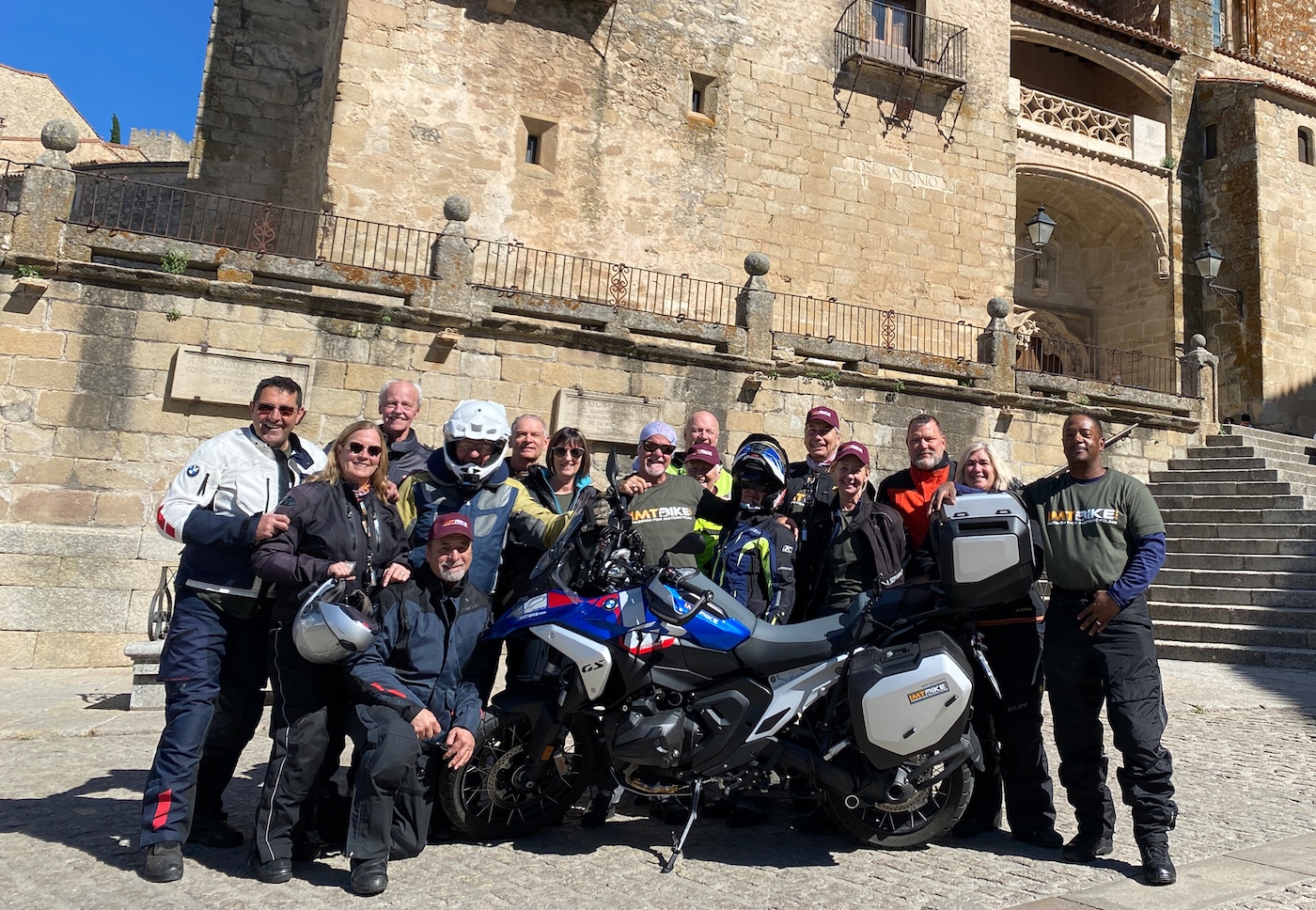
After a brief break for coffee, we descended the mountains towards Segovia, a city famous for three landmarks: an ancient Roman aqueduct, the Cathedral of Our Lady of the Assumption and Saint Fructus towering high above the city and the Alcazar of Segovia. It is an 11th-century medieval castle and one of the most visited landmarks in Spain.
During the ride away from Madrid, I worried about how much Judy was enjoying her crash-course in riding. Later that day, I knew everything was going well when she said, “I see why you like this!” On our lunch break in Segovia, we wandered the city and enjoyed a delightful meal at a quaint restaurant off a side street. Though our waiter spoke no English, our basic Spanish skills were enough to be understood. We reminded each other that this was truly an incredible immersion into local culture and the best way to see Europe.
Continuing our exploration of Segovia, we eventually made our way back to the bikes just as the rest of our group did, and soon we were off toward the town of Avila, our destination for that evening, winding through the beautiful Spanish countryside.
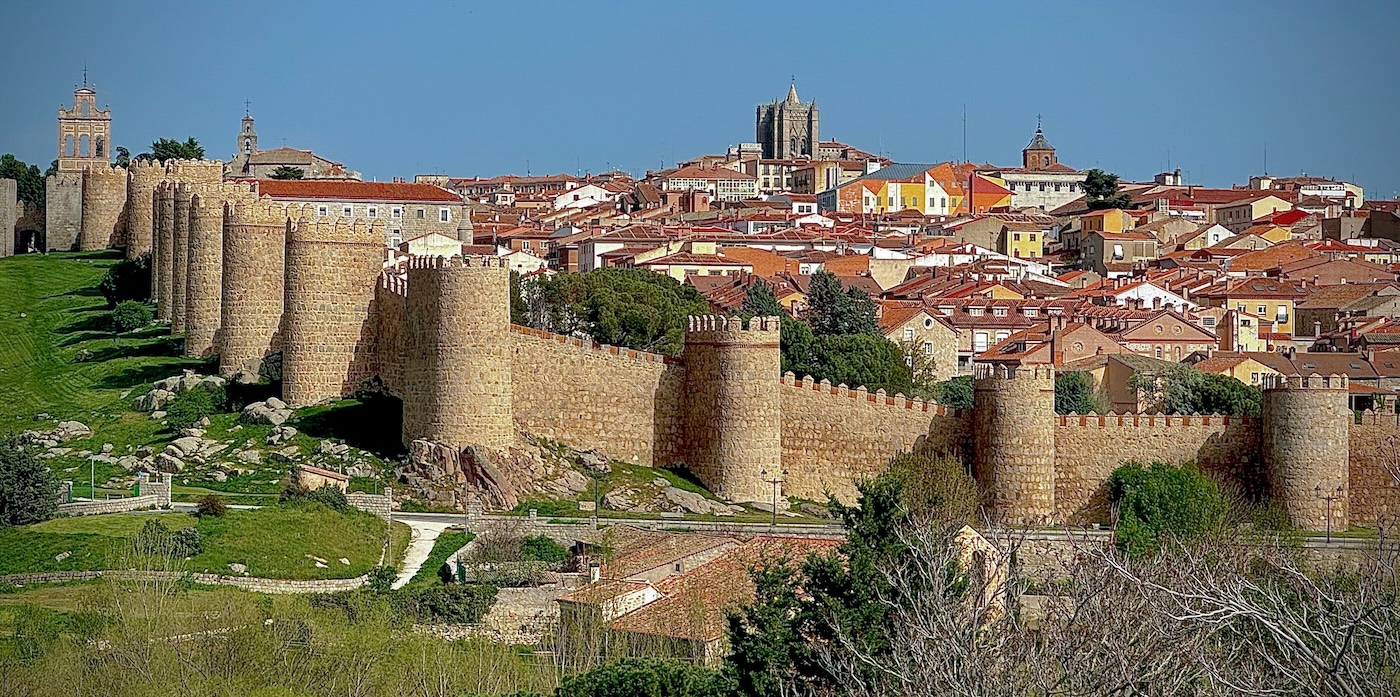
Avila is one of Spain’s best-preserved medieval cities and is known for its rich history and tradition. The walls of Avila stretch more than a mile and a half around the city and include 87 towers and nine gates. From the walkway atop the walls, visitors take in breathtaking views of the city and surrounding countryside, especially in the evening when the walls are illuminated.
Our accommodations for the evening were at the Parador De Avila. A Spanish parador is a state-owned luxury hotel typically located in buildings of historical significance such as castles, monasteries or palaces. Currently, 98 paradores stretch across Spain in a network established by King Alfonso XIII in 1928 with the primary purpose of rehabilitating empty historical buildings and using the revenue from the hotels to maintain them for future generations, all while giving visitors a unique experience into Spain’s rich history and culture.
A similar network exists in Portugal, where they are called Pousadas. Like their counterparts in Spain, pousadas both promote tourism and preserve historical buildings. All of the Spanish paradors and Portuguese pousadas we stayed at during our IMTBike tour offered first-class accommodations, delicious and authentic dining options and memories we will carry with us forever. For the evenings we didn’t stay at paradors or pousadas, we stayed at high-end hotels.
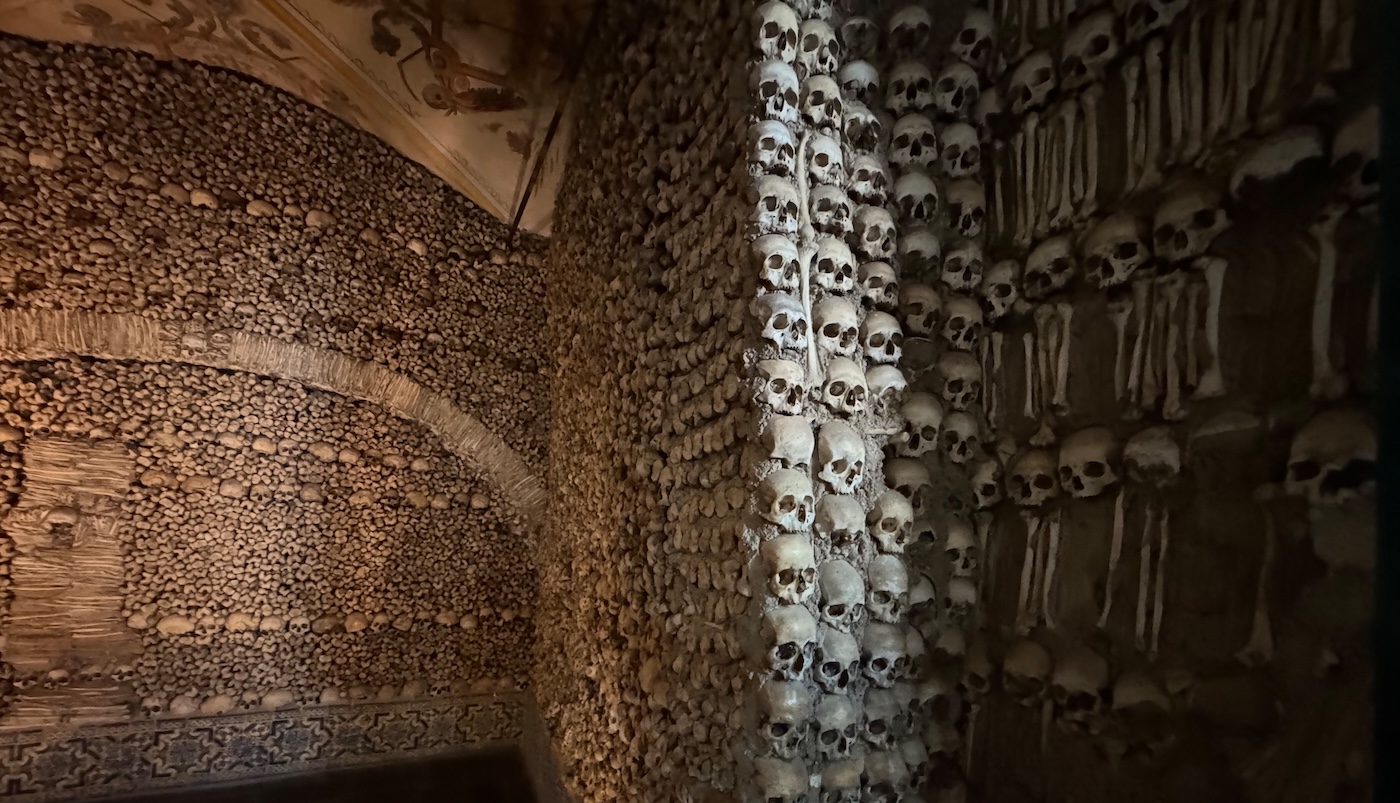
Leaving Avila, we continued west across beautiful twisting roads into the Sierra de Gredos mountains and a pine forest landscape dotted with boulders with snow lingering on the highest peaks seen in the distance.
Along the way, Sergi and Chano lead us on a detour up a winding mountain road to get another glimpse into the region’s rich history–one of the ancient Roman highways still visible. Off the bikes, we took the opportunity to walk these ancient roads built with gravel, sand and tightly-fitting stones while wondering who may have traveled over them more than two centuries ago.
Back on the bikes, we continued our ride to Ciudad Rodrigo, our stop for the evening just miles from the border of Portugal, before pushing on to Porto the next day. Porto, the second largest city in Portugal, is located along the banks of a canyon cut by the Duoro River and is famous for its wine and beaches. Our rest day there offered us the opportunity to explore the city, eat fresh seafood and enjoy the beautiful views.
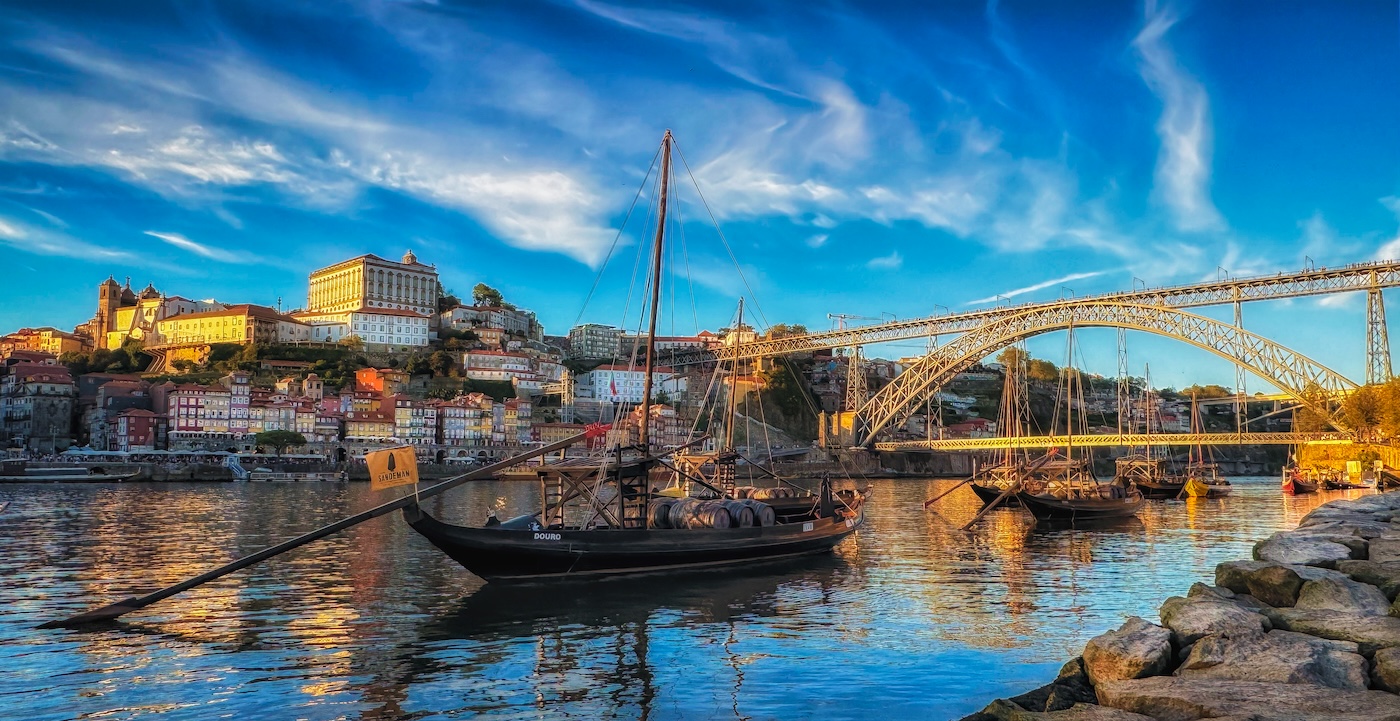
From Porto, we rode south to Tomar, then Cabo Da Roca along the Atlantic Ocean near the oldest lighthouse in Portugal and the westernmost point of Europe. We’d spend the next two days in the small fishing village of Cascais, which, legend has it, is the town where Ian Fleming came up with the idea for James Bond.
From Cascais and now just over halfway through our tour, we rode east to Merida, then north past olive groves and vineyards serving as a link to the region’s history shared with its ancient Roman inhabitants. Fields of lavender cover the rolling hills beside the road we travel.
Sergi told us to watch for Iberian pigs wandering the olive groves and oak trees found in this region. Jamón Ibérico is the meat of a cured rear leg of free-range black Iberian pigs specifically fed on acorns for the last four months of their 15-month life. Quintessentially Spanish and exclusive to four different areas of Spain, it is probably the most delicious and sought-after cured meat in the world.
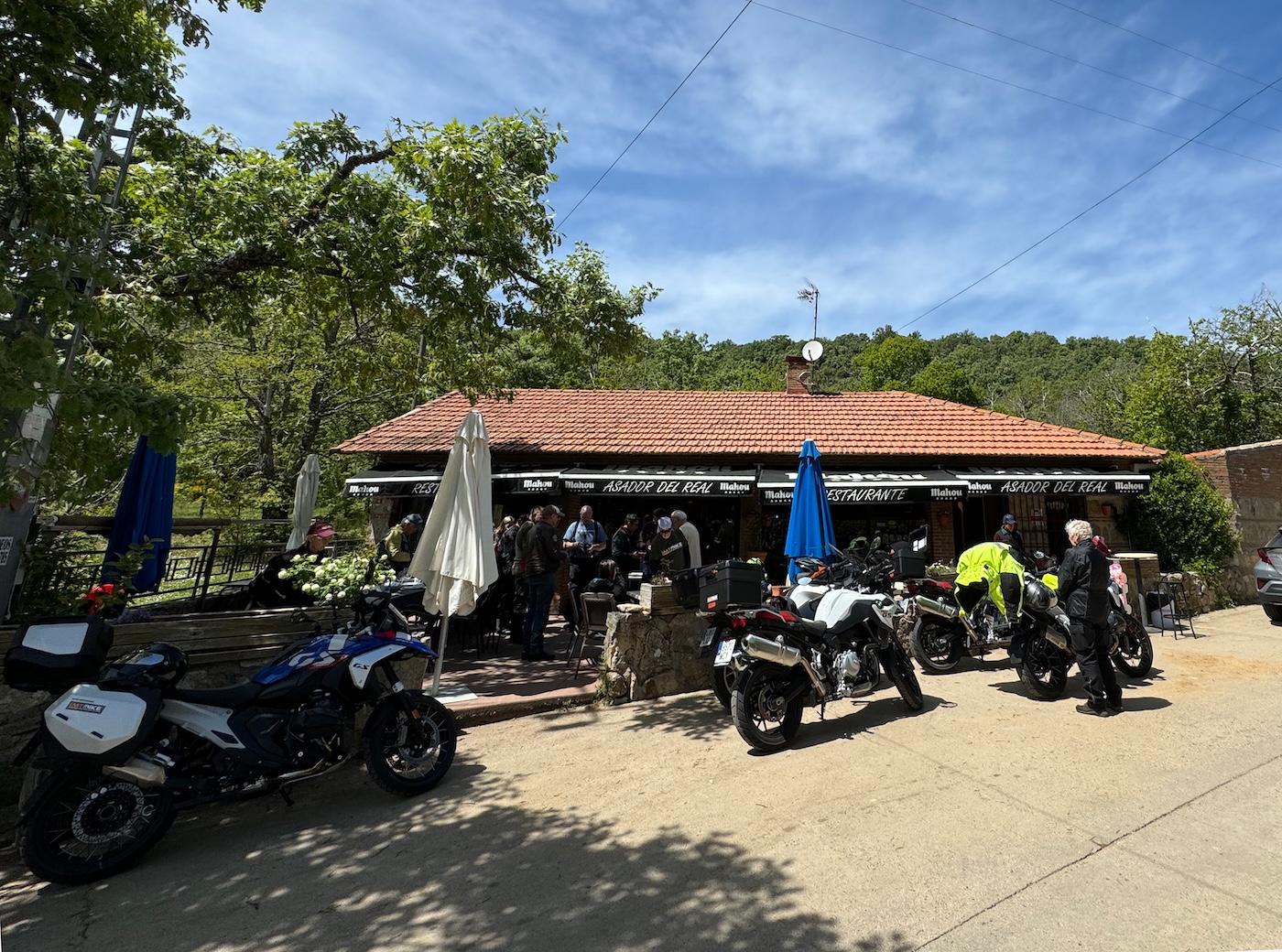
Spring hadn’t yet arrived in the mountains as we approached Jerandilla and, as the temperatures kept our bodies cool, the heated grips blazed on to keep my hands warm. The cool weather brought with it a light rain as we prepared to leave the next morning. Pulling away, the temperature gauge on the TFT display read 7° Celsius, which I quickly calculated to be about 44° Fahrenheit. The beautiful mountain roads we rode reminded me of Colorado as we followed a river meandering through endless stands of tall pines. I thought to myself, this would have been a great ride in clear weather, but as it was the only rain we experienced during our tour, I couldn’t complain. As that thought passed through my brain, the rain picked up and the temperature dropped another degree. Chilled, our morning stop couldn’t come fast enough. Luckily, the coffeeshop we pulled into had a roaring fire to warm up next to–thanks again to Sergi and Chano and their local knowledge!
From Toledo, our route took us south along the Tejo River as colorful pastels colored the hills surrounding us as we rode toward Consuegra. This interstate-like ride through the arid countryside continued until, in the distance, we could see windmills perched high atop the hills near the town of Consuegra. This small La Mancha town is famous for its perfectly restored castle on the hilltop surrounded by windmills. Several of the windmills date back to the 16th century and were pivotal in developing the agriculture of the area.
Leaving Consuegra took us on a path through lush fields of olive groves, vineyards and wheatfields. The terrain slowly changed to become hillier as we enjoyed the long sweepers breaking the monotony of the boring highway. We were on a fast run to Cuenca and a return to the lovely mountain roads we crave. Overlooking the Jucar River, the picturesque streets, antique facades and cathedral are all worthy sites, but Cuenca is really known for its hanging houses which seem to defy gravity as they hang out over the abyss below.
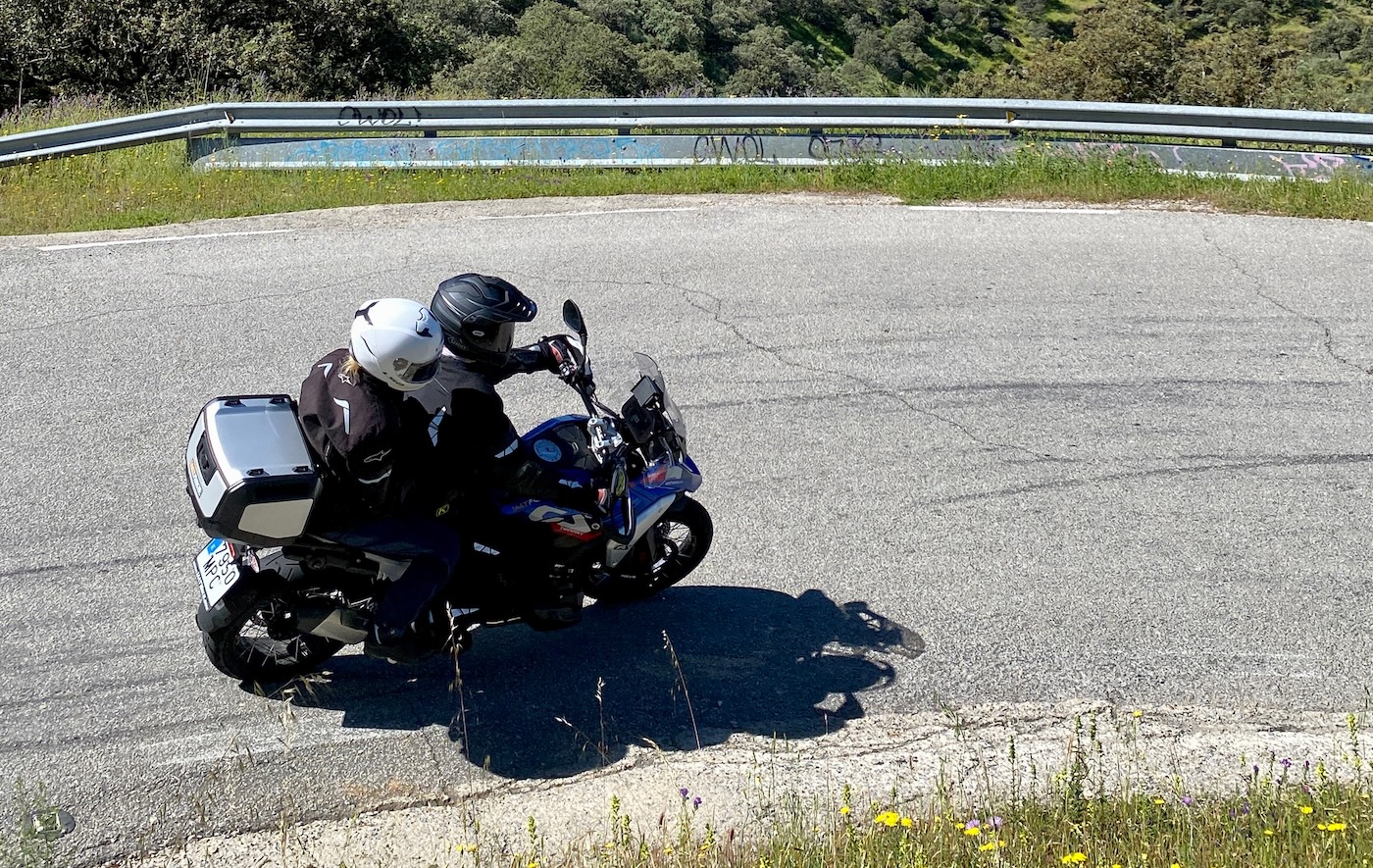
A feeling of melancholy grew within the group; we knew it was our last evening together. At dinner, we raised our glasses to toast a great ride, our two excellent guides and to new friendships. Once again, sleep was difficult as I recounted not only that day, but highlights of our previous days riding through the quaint Spanish towns, over breathtaking mountain roads and dining on incredible cuisine.
Our final day of riding took us into the spectacular Cuenca Mountains for a traffic-free ride with more stunning views and twisting roads of perfect asphalt. Late that afternoon, we were back to where our tour began, IMTBike’s headquarters in Madrid.
As long as I’ve been riding, I’ve never enjoyed riding in large groups and have always been more comfortable riding alone or with one or two others. With just a couple of riders, it’s easier to reach a consensus on where we’ll go, when we’ll stop and when we’ll return. Additionally, we typically all know each other and each other’s tendencies and riding style. We alternate leading with no defined alpha at the head of the pack. This ride changed my opinion of larger group rides.
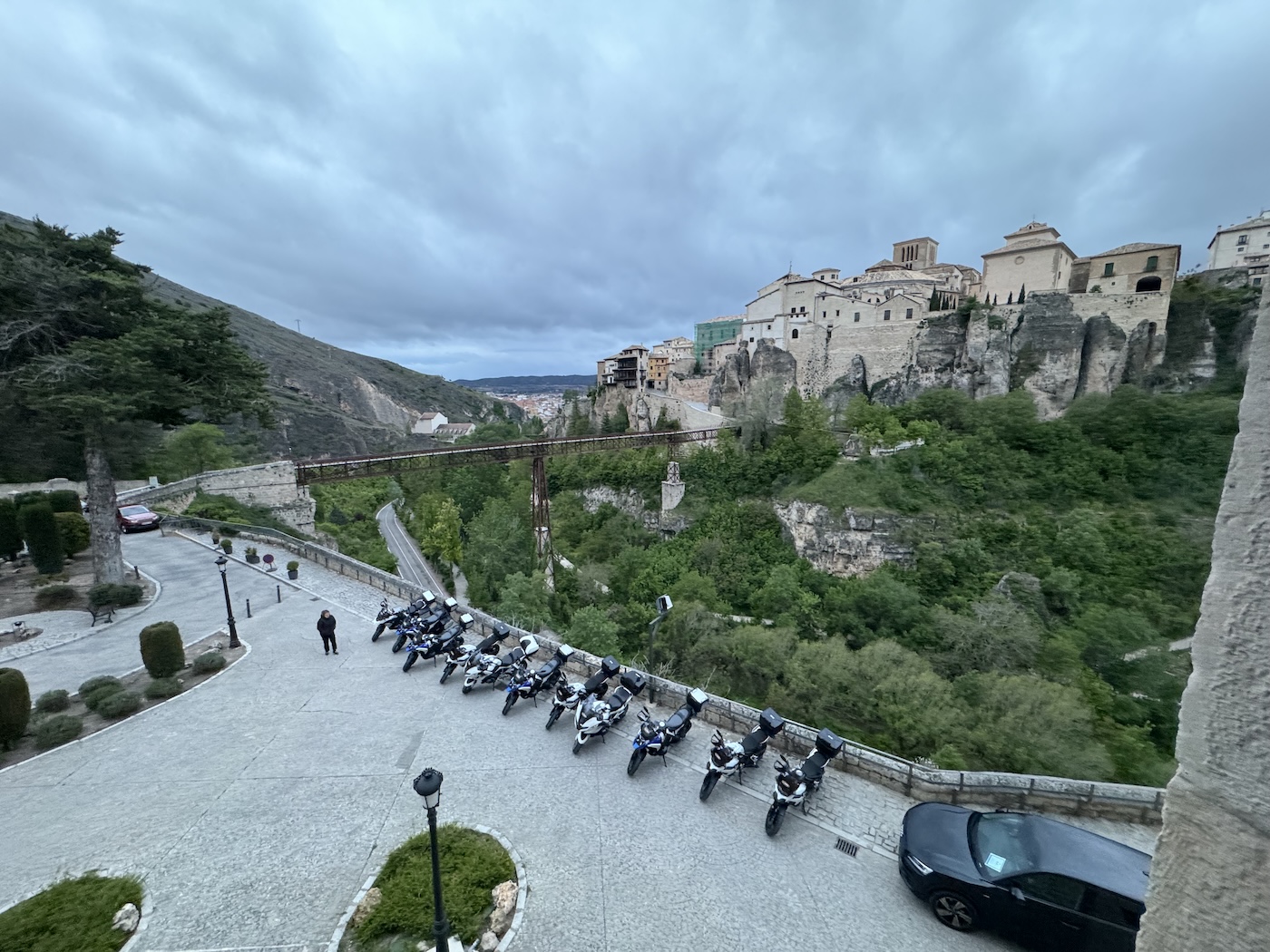
On our tour, guides Chano and Sergi alternated between leading us and driving the chase van. Whoever was leading took care to make sure our group stayed together, and while the ride was spirited at times, I never felt the need to push beyond my comfort zone as the voice of my daughter warning me not to kill her mom played in my head!
During our initial meeting that first day in Madrid, we learned that in addition to their structured group tours like the one we were about to embark upon, IMTBike also offers bike rentals for those wishing to explore Spain and the neighboring countries alone, or with another rider or two. While those rentals included a GPS, maps and a list of suggested sites to visit, they don’t come with the local knowledge of our two guides–like the ancient Roman highway they brought us to. Because Sergi and Chano are both Spanish citizens and avid motorcyclists themselves, they know the local customs of our destinations along with the hidden, off-the-map must-see places to visit. On top of that, they speak the language, making it much easier when visiting the quaint, off-the-beaten-path villages we’d see every day.
Since our IMTBike tour, Judy and I have taken a Viking cruise up the Rhine River from Basel, Switzerland, to Amsterdam, enabling us to see even more of Europe. Comparing the two trips is like trying to compare an apple to an orange.
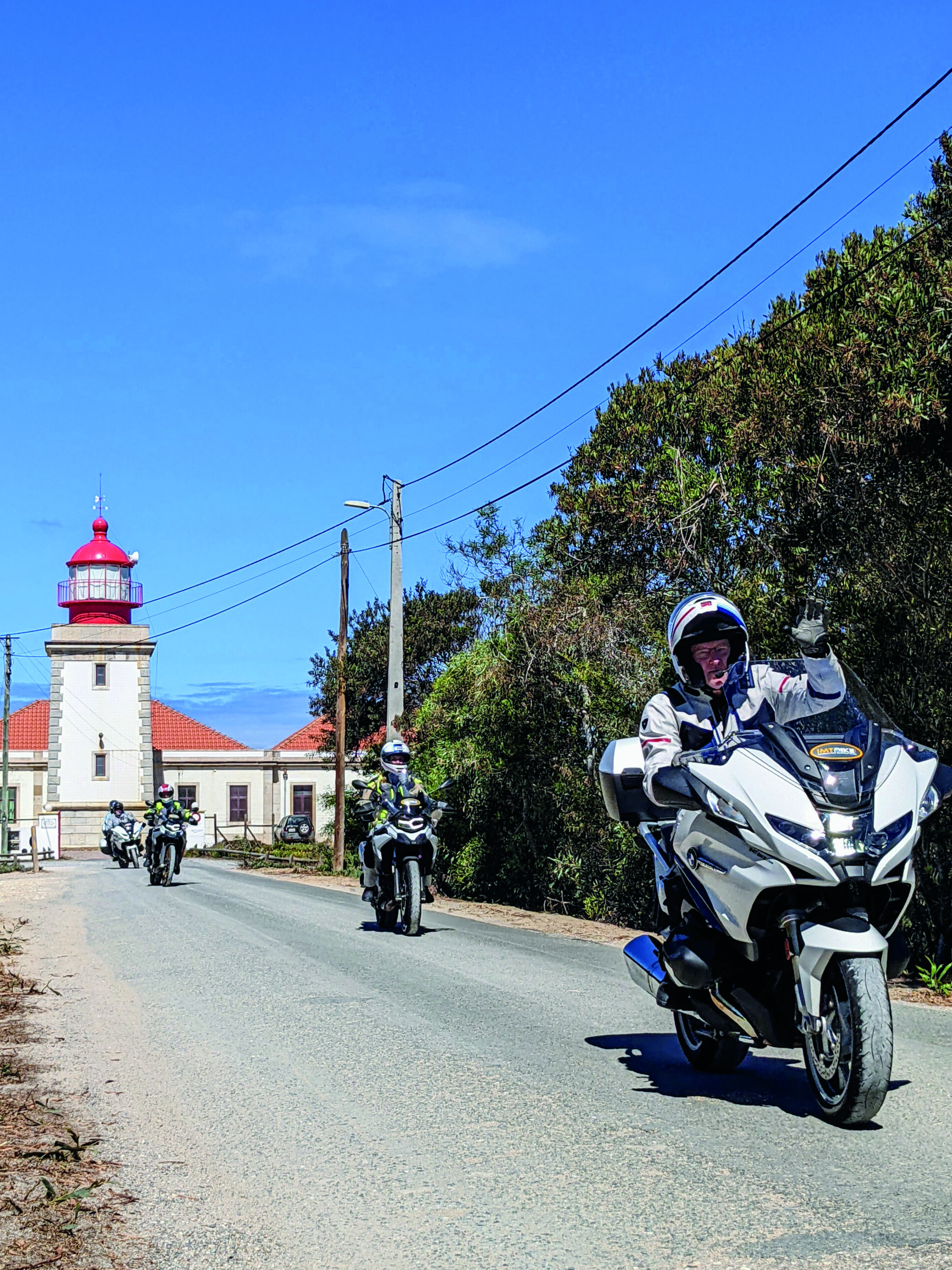
Riding through Spain and Portugal offered an immersion into the towns and villages we rode. During our three rest days, we became more than simple sightseers, but were able to tour these cities, observe local culture and taste the cuisine to truly get an authentic experience of the places we were visiting. Each day of our two-week tour gave us a new perspective.
Aboard the Viking Cruise ship, our experience was much different. As motorcyclists, it’s best explained by defining the difference between riding a motorcycle, which engages our senses as we become part of the world we are riding through. On a cruise ship, we spent most of our time watching the world go by as we sailed through it. While we saw many beautiful landscapes and incredible castles as we sailed by, for the most part, we couldn’t truly experience what we were sailing past.
IMTBike gave Judy and me an experience we will never forget, and we are already looking forward to another tour in the future. IMTBike is offering another tour especially for MOA members this coming spring with their BMW MOA Best of Portugal Motorcycle Tour with MOA President Brian Dutcher and his wife Tricia.
If you are interested in joining Brian and Tricia on an unforgettable 15-day “Best of Portugal” tour in 2026, please visit IMTBike.com for complete details.